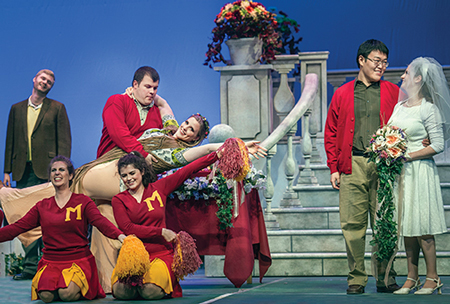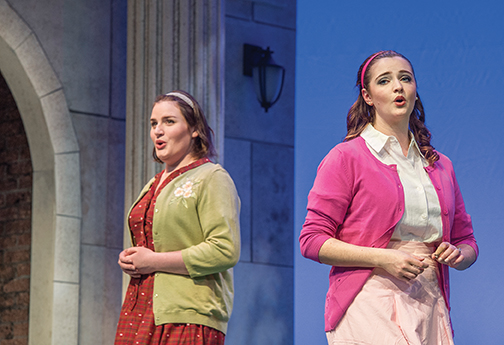by Daniel Hathaway
 Beatrice and Benedict of Shakespeare’s Much Ado About Nothing might have been surprised enough to find themselves recast in Hector Berlioz’s operatic sequel, Béatrice et Bénédict. What would those two eventual lovers have thought about their translation to a 1960s American university during football season? Director David Bamberger’s updating of Berlioz’s 1862 work for the CIM Opera Theater on Wednesday, February 24 certainly brought a fresh perspective to an old story, even with a few cultural dissonances.
Beatrice and Benedict of Shakespeare’s Much Ado About Nothing might have been surprised enough to find themselves recast in Hector Berlioz’s operatic sequel, Béatrice et Bénédict. What would those two eventual lovers have thought about their translation to a 1960s American university during football season? Director David Bamberger’s updating of Berlioz’s 1862 work for the CIM Opera Theater on Wednesday, February 24 certainly brought a fresh perspective to an old story, even with a few cultural dissonances.
Shakespeare’s (and Berlioz’s) protagonists are warriors returning from battle; Bamberger’s are gridiron heroes at Messina University on the eve of the hippie revolution. Burgeoning social tensions are revealed during the overture when Beatrice, a campus activist who is spotted tacking up protest signs, tussles with cheerleaders who pummel her with pom poms.
Unlike Claudio the quarterback and Hero his betrothed, Beatrice the counterculturist and Benedict the football star want nothing to do with each other. That situation will suddenly and rather inexplicably change later in the show, but B&B spend most of the first act publically avoiding each other. “I’d rather be a monk in a Benedictine monastery,” he says in one punning aside.
As Claudio, the sturdy baritone Ziaoyang Zhang made an early appearance peering into what looked startlingly like a flip phone. No anachronism, it turned out to be an engagement ring case. As “his biggest fan,” Hero, soprano Halla Kalmansson was sparkly and appealing, tossing off high notes and cadenzas in her introductory aria with confident abandon.
Berlioz gives Benedict a number of end-to-end arias to negotiate, and tenor Kevin Adamik was up to the task, singing with warmth and stamina. As Beatrice, soprano Kaitlin Borden was both a strong actor and mature vocalist, singing her second-act aria while caressing a football. The other leads in this strong cast included basso Daniel Fridley as Don Pedro (the football coach), mezzo-soprano Elora Grace as Hero’s mother (and the Dean of Students), soprano Laura Salyer as Hero’s best buddy Ursula, and soprano Lauren Wickett as the Messenger. (They also sang these roles on Friday evening. A second cast took over for the Thursday and Saturday performances.)

In the second act, the chorus, who had made multiple entrances and exits down the aisles of Kulas Hall, and who later sang a wedding song from the rear of the auditorium, joined the principals for a festive brindisi, one of the slightly discordant elements in the production. On an American university campus in the 1960s, wine was unlikely to be the beverage of choice. Taking things just a bit further into the 20th century might have been more plausible — and you could diss the quality of the beer by rhyming “suds” with “Buds” just as easily as the English supertitles rhymed “brine” with “wine.”
In the pit, the CIM Orchestra played well under Harry Davidson’s nicely-paced direction, though Berlioz’s complicated violin parts sounded a bit scrappy at times.
The bright set, a university quadrangle with a classical façade and staircase, was cleanly designed and lighted by Dave Brooks and served for the entire opera, accessorized from time to time with Japanese lanterns and banners. Alison Garrigan’s period costumes were evocative of the era.
Photos by Rob Muller courtesy of the Cleveland Institute of Music.
Published on ClevelandClassical.com March 14, 2016.
Click here for a printable copy of this article


